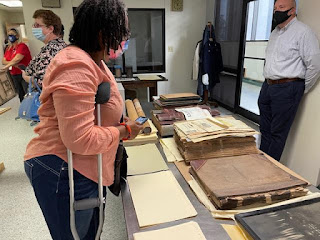 |
| Amite Genealogy Library Photo Credit: Walter C. Black, Sr. |
Several years later, I began blogging about the people and local history of the Florida Parishes. Currently the blog post has close to 400,000 readers globally. Periodically, I produced several short films about the some of the people and the local history. A number of highlighted articles have been published in the local newspapers, including the Daily Star, Tangi Digest, and the St. Helena Echo. My third objective was to establish African American collection at the Center for Southeast Louisiana Studies. Four African American Collection have been established; Bernice Bennett Collection, Dr. Kingsley B. Garrison, Antoinette Harrell, and Richardson Funeral Home, Inc, Amite.
 |
| The Daily Star Newspaper. |
Additionally, the East Baton Rouge Parish Library Special Collections was added as a repository for the African American funeral programs. The programs will be scanned and made available on their library's websites for researchers. The Amistad Research Center in New Orleans, Louisiana received an extensive collection as well. The book entitled " Images of America" African Americans in Tangipahoa and St. Helena Parishes was published approximately three years ago and now the book sit on the bookshelves in libraries, museums, and the Louisiana State Archives. One of the other major accomplishments were documenting nine African American cemeteries in Tangipahoa and St. Helena Parishes. My youngest son Bernard and my colleague Ilona Little helped me to document the cemeteries and made them available on the USGenWeb site for genealogy research for anyone researching their family history in the Florida. Parishes. There are others that needs to be recorded. Most of the churches do not have a record of who is buried in the cemetery. I would like to talk with the leaders and secretaries of the churches and ask them about keeping records of the deceased buried in their cemetery.
It has truly been a rewarding journey and I'm looking forward to the next chapter of this journey. In the near future, I would like to have interns who can train under me so that I can prepare myself to pass the torch to the next generation who are interested. Hopefully next summer, I will get interns and volunteers to help me to continue documenting the history of the Florida Parishes. In some cases I need to create databases of some of the finding.
The Florida Parishes had gained exposure as a result of my guest appearance on internet radio and zoom broadcasts about the history and people. Numerous of filmmakers, writers, magazine publishers and. other media outlets regarding my research. In the coming years, I intend to collect oral history from the elders in the community. As I ponder on the subjects, that will determine how I will find the people I want to interview.
 |
| Peonage Research Documentary Photo Credit: Walter C. Black, Sr. |
Source:
The USGenweb Archives Part of the The USGenWeb Project (Tangipahoa Parish Index)
http://www.usgwarchives.net/la/tangipahoa/cemeterya.htm
Dr. Antoinette Harrell Collection
Richardson Funeral Home, Inc. Amite Collection
Dr. Kingsley B. Garrison Collection
Bernice Alexander Bennett Collection
The Amistad Research Center
http://amistadresearchcenter.tulane.edu/archon/index.php?p=accessions/accession&id=1248


